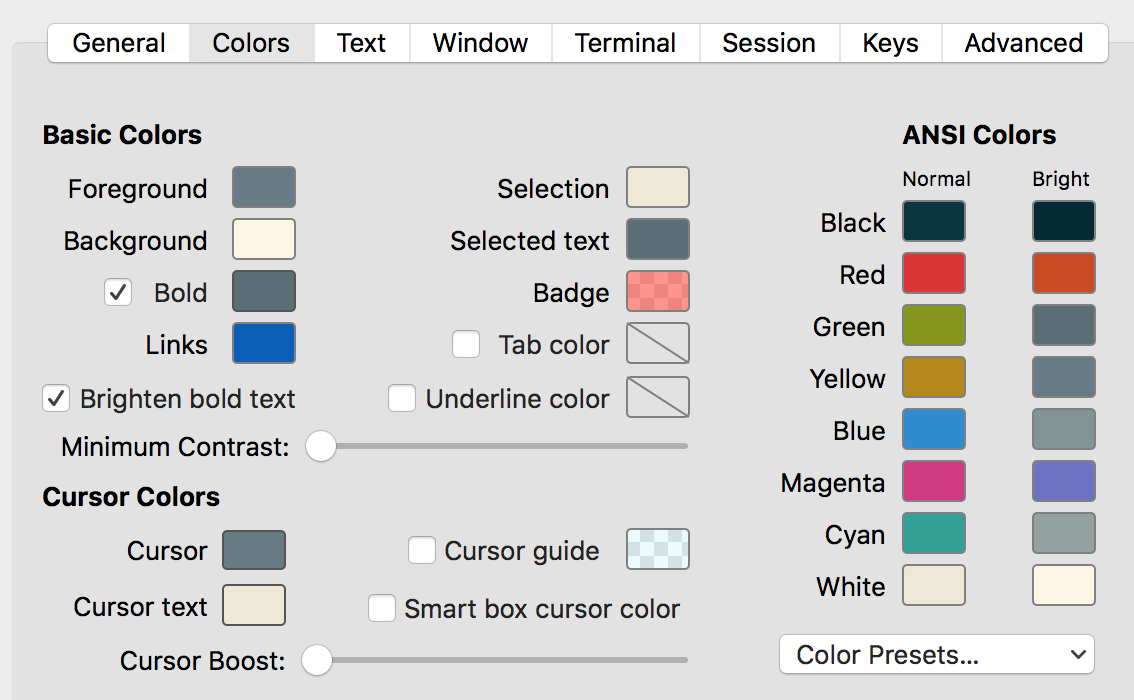

- #SOLARIZED COLOR SCHEME UPDATE#
- #SOLARIZED COLOR SCHEME WINDOWS 10#
- #SOLARIZED COLOR SCHEME CODE#
- #SOLARIZED COLOR SCHEME WINDOWS 7#
You will also want to revert any changes you made to your PowerShell profile.
#SOLARIZED COLOR SCHEME UPDATE#
There is enough interest and demand, a future update may make it possible toĪpply other themes using the Update-Link utility, but for now it is not very Not recommended for casual users is to edit the Properties of an open window.įrom there, you can edit the colors manually, using the table as a guide. But you can't set a palette in your bashrc. If you'd like to set up the palette in gnome-terminal or Eterm, nothing's stopping you from doing so. The solarized theme is the color palette you can do what you want with it after it's configured. Unfortunately, this is not the easiest to revert right now. Your example is selecting colors out of a palette to colorify parts of the bash prompt. Previously, regedit /s windows-defaults.reg.
#SOLARIZED COLOR SCHEME WINDOWS 7#
The registry settings have beenĬhecked for versions of Windows back to at least Windows 7 and the values are The file windows-defaults.reg is provided to restore the command promptĬolors back to their shipping defaults. If you use Solarized without these colors, Solarized will need to be told to degrade its colorscheme to a set compatible with the limited 256 terminal palette (whereas by using the terminal's 16 ansi color values, you can set the correct, specific values for the Solarized palette). (Join-Path -Path (Split-Path -Parent -Path $PROFILE) -ChildPath $(switch($HOST.UI.()))) Now open aĬommand Prompt to the location of this project. Shift and right-click on the shortcut, then select Copy as path. This will open an Explorer window and show you the shortcut.

When it appears in the list, right-click and select Open file location.
#SOLARIZED COLOR SCHEME WINDOWS 10#
The easiest way toĭo this on Windows 10 is to click Start, then type in the command you want toĬhange. Locate the link you wish to modify, such as Command Prompt. Update Command Prompt and PowerShell shortcut. The fly with color 01 for dark and color F6 for light. Therefore you can switch between themes on regedit /s solarized-dark.reg.īoth files contain the same palettes, the only difference is the defaultįoreground and background colors. Process is now to use the Update-Link utility. It is still something you may wish to do, but the recommended While this was the original process, this only changes the registry defaultĪnd doesn't update the Command Prompt and PowerShell defaults when you launch
#SOLARIZED COLOR SCHEME CODE#
Nice with traditional unix tools or compatability shims because Windows uses aįundamentally different color code mapping. Latest version of the project, it is possible to apply to existing shortcuts,īut it will not be easy to revert that change. It will not updateĮxisting shortcuts because they have their own color mapping. WARNINGīelow are very simplified installation instructions. Seemingly fit with the rest of the environments.

The PowerShell defaultĬolors are also matched for the $Host.PrivateData and PSReadLine to make them Sequences to show the same in ANSI supported terminals. These values were pulled from PuTTYĪnd other Solarized terminal profiles. To make sure that the terminal is likely to use the best matching, theĬolorTable is aligned with TERMCOL values. The following table shows how the colors are mapped. Making Solarized work for cmd.exe, Bash on Ubuntu on Windows, and PowerShell,Īnd striking a balance with how other Solarized projects are implemented Reports or issues, please visit the GitHub repo for this port, See the Solarized home page for screenshots and more details,Īs well as color schemes for other applications. With contributions by Neil Pankey, Ryan Beesley, Scott Hanselman, Even so, the colors I get on my own screen seem somewhat different from what I see on the Solarized website.This is a Solarized color scheme for the Windows command prompt,

For this particular scenario, installation was not trivial: I've had to configure Solarized for PuTTY, and then configure it for Vim as well. I've been using Solarized for a few weeks now, mainly in Vim via Putty. The two screenshots above were taken from that very page, where you can find many other screenshots showing different file types in Vim, as well as many other applications. Solarized has a gorgeous webpage (colorized according to the scheme, of course), where the author lays down his reasoning for the scheme and its advantages in excruciating detail. Most color schemes are just a single text file with hardly any documentation. The number of colors can even be brought down further, to just five specific hues, and it would still be quite readable.Īnother thing that's very impressive about Solarized is the presentation. It's a minimalistic scheme, with just sixteen colors. In fact, they're both readable to the same exact degree: they have symmetric lightness differences, so switching between dark and light background retains the same perceived amount of contrast between scheme elements. They feel like one color scheme, but both are very readable.


 0 kommentar(er)
0 kommentar(er)
